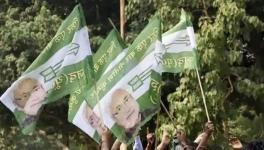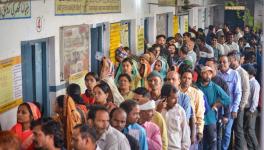Why Modi’s Ayushman Bharat Collapsed in Bihar as AES Continues to Kill Children
Image for representational use only.Image Courtesy : The Financial Express
New Delhi: Bihar has lost around 152 children in 20 districts and (130 alone in Muzaffarpur district) because of suspected Acute Encephalitis Syndrome (AES) since June 1, prompting the Supreme Court and the National Human Rights Commission (NHRC) to express anguish and issue a notice to the Union Health Ministry and Government of Bihar asking for response.
Most of those whose children have died belong to the poor socio-economic background for whom the Narendra Modi government’s health scheme – the Ayushman Bharat Yojana (PM-JAY) – was launched in September, last year with much fanfare.
The database of 2011 Socio Economic Caste Census (SECC) has been used for identifying and enrolling beneficiaries in the scheme. While the beneficiaries can avail benefits in both public and empaneled private facilities, the payment for treatment will be done on package rate (to be defined by the government in advance) basis.
According to the SECC, a family living in a two-room pucca house, owning a two-wheeler or a refrigerator or even a landline phone will be ineligible to take benefit under the world's largest government-funded health care programme (as the government calls it) in rural areas. However, scheduled caste and scheduled tribe households are eligible under the scheme. In urban areas, a household with monthly income of more than Rs 10,000 is not eligible to seek coverage under Ayushman Bharat.
The scheme is aimed at providing a cashless medical care to the tune of Rs 5 lakh per family every year for secondary and tertiary care hospitalisation in private or government hospitals. However, only around 35 children suffering from brain fever – according to reports – availed treatment under the health insurance scheme.
Why did the healthcare scheme fail to reach remote villages of Bihar with second largest number of ‘below poverty line’ (BPL) families in the country? This is unexplained so far. But the possible answers could be many:
One, a large number of those affected by the brain fever do not know about the procedures to avail free treatment under the scheme. There is no awareness campaign for the same. The beneficiaries, in the time of need, are required to visit an empaneled hospital and meet the official (the Ayushman Mitra) who facilitates a link between the patient and the hospital.
The Ayushman Mitra checks eligibility of the patient’s family and their enrolment under the scheme. Then, the beneficiary is provided with a QR code, which is scanned and verifications are done.
According to the National Health Authority (NHA), which keeps an eye on implementation of Ayushman Bharat, the state has 564 government hospitals and 84 private hospitals empaneled under the scheme. In Muzaffarpur, the total number of empaneled hospitals (both public and private) stands at 28.
The state – according to the NHA figures – has 16,14,174 PM-JAY eligible families of which only 16,14,174 (around 16%) have been issued Ayushman Bharat e-cards to avail treatment under the scheme.
Two, states like Bihar don’t have a good network of private hospitals because majority of them are concentrated in bigger cities. This might be one of the reasons that Sri Krishna Medical College and Hospital (SKMCH) has been witnessing highest number of patients’ footfall and has reported around 117 deaths so far.
Three, such states lack administrative infrastructure and have several logistical issues to enroll their underprivileged for the scheme.
Four, the scheme works on the state-Centre contribution towards the total expenditure. The state has to pay 40% of the total amount of disbursal, while the Centre gives 60%. This is where the actual problem lies in case of the poor states. It is easier for richer states to provide their share of contribution to ensure implementation of the scheme.
The Modi government – in its interim budget (2019-20) – has earmarked Rs 6,400 crore for Ayushman Bharat. But only those states that pay their 40% share can avail this fund. The states, which cannot provide their share of funds don’t get money allocated by the Union government.
The Ministry of Health and Family Welfare, Government of India, in response to a question on the implementation of the scheme, said in a written reply on June 21 that a total of Rs 3,077 crore has been disbursed against 23.26 lakh claims (as on June 18, 2019).
Gujarat topped the list by securing Rs 641 crore. Other states with considerable share include Chhattisgarh (Rs 379 crore), Karnataka (Rs 368 crore) and Tamil Nadu (Rs 349 crore).
Bihar could raise only 39,943 claims and it got an abysmal Rs 34.58 crore. Against 1,05 claims, Uttar Pradesh with highest number of BPL, got Rs 117 crore from the Centre. With just 14,000 claims, West Bengal received Rs 14.14 under the scheme.
Also read: Skeletons Found in SKMCH’s Backyard, AES Patients Continue to Suffer
Get the latest reports & analysis with people's perspective on Protests, movements & deep analytical videos, discussions of the current affairs in your Telegram app. Subscribe to NewsClick's Telegram channel & get Real-Time updates on stories, as they get published on our website.
























